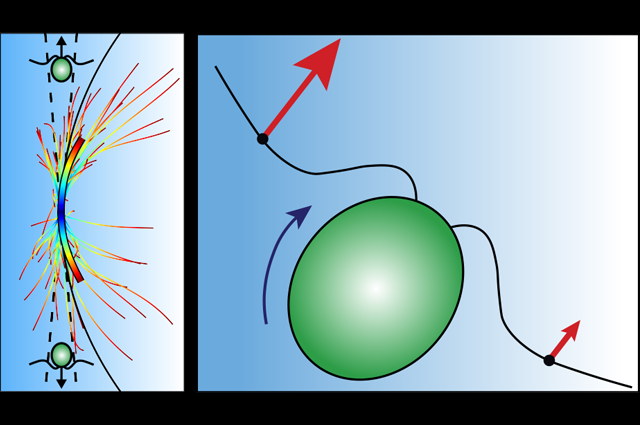Microbial transport

Microbial movement regulates biological functions from reproduction in animals to photosynthesis in single-celled plankton and bacterial infections of endangered coral. These swimming cells are susceptible to changes in the viscosity, or thickness, of the fluid, which can be locally augmented in biofilms and mucus.
Numerous studies have described the movement of swimming cells in homogenous, or single, viscous fluids. However, microorganisms are often found in inhomogenous viscous environments. These environments contain both a high and low viscous fluid creating a gradient. Despite the importance of microorganism movement in varying viscosities, a definitive paradigm for swimming cell transport in viscosity gradients has not been established. Additionally, the physical mechanisms controlling cell motility within these gradients have also remained unresolved.
Recent work by Associate Professor Jeffrey Guasto’s group of the Department of Mechanical Engineering and colleagues analyzes the movement of biflagellated microalgae (Chlamydomonas reinhardtti) within controlled viscosity gradients. The results provide the first direct evidence of biflagellated microalga’s viscophobia, or its aversion to accumulating in high viscosity regions.
The research team designed microfluidic devices to precisely control the strength of the viscosity gradient. They created a stratified viscous environment using polymer additives to locally increase the viscosity. Observations performed in the absence of a viscosity gradient showed that the cells randomly move and spread out uniformly across the channel. A moderate viscosity gradient yields a slight accumulation in the high viscosity region due to a reduction in cell swimming speed as expected. However, a strong gradient reveals a viscophobic outcome in which the swimming cells accumulate in the low viscosity regions. This result runs counterintuitive to some theoretical studies whereby cells are predicted to accumulate in high viscosity regions and exposes an underlying viscophobic movement bias within the cells.
The team hypothesizes that this viscophobic movement is due to the cell experiencing a slight imbalance in the pulling force between its two flagella. The flagellum in the higher viscosity exerts a larger force on its surrounding compared to the flagellum in the low viscosity, resulting in a rotation that directs the cell down the gradient. This reorientation enables the swimming cells to escape from the high viscosity region. The team also observed mutant C. reinhardtii with shorter flagella rotated slower, supporting the hypothesized model that guides cell transport in viscosity gradients.
The team’s discovery has the potential to refine our understanding of swimming cell movement in complex microbiological systems. The experimental and analytical approaches established in this work pave the way for understanding cell motility in a range of important environments, from biofilms to protective mucus layers to endangered coral ecosystems.
Read the full letter, “Viscophobic turning dictates microalgae transport in viscosity gradients,” in Nature Physics.
Department:
Mechanical Engineering